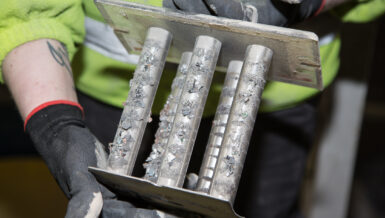Bunting is one of the world’s leading designers and manufacturers of magnetic separators for the recycling and waste industries. The Bunting European manufacturing facilities are in Redditch, just outside Birmingham, and Berkhamsted, both in the United Kingdom.
CRS NI (Complete Recycling Systems) is a leading player in the UK waste processing market, designing and manufacturing bespoke Material Recycling Facilities (MRF) to suit any size operation, from in-line trommel plants to full co-mingled waste plants as well as original plant extensions and “add-ons”.
After an extensive review of recycling equipment suppliers at the end of 2020, CRS selected Bunting-Redditch to supply the metal separators. The configuration of the waste processing plant led to the selection of three (3) ElectroMax Overband Magnets and one (1) Eddy Current Separator with a vibratory feeder.
The Model EMAX150 ElectroMax Overband Magnets recover steel cans and other ferrous metals from the conveyed waste. One is suspended inline with a conveyor, over a non-magnetic head pulley, with the remaining two positioned across the conveyors. All the ElectroMax models feature compact, air-cooled, high-powered electromagnets with heavy-duty self-cleaning rubber belts. In operation, the waste passes under the electromagnet on a conveyor where any ferrous metal attracts up and out of the burden. The self-cleaning belt transfers captured ferrous metal out of the magnetic field, discarding it into a collection area. Each EMAX150 weighs 2.8 tonnes and is 2750mm long, 460mm high, and 1590mm wide.
In this project, two of the conveyors are 1200mm wide for the cross-belt installation, with the third being 1500mm for the in-line position. There are three size fractions: <50mm, 50-150mm, and 150-400mm with the burden depth on all three conveyors averaging around 300mm.
The 1500mm wide Eddy Current Separator, with integrated vibratory feeder, is located later in the process and recovers non-ferrous metals such as aluminum cans. The HIC Model (high-intensity concentric) features a 300mm diameter magnetic rotor. The vibratory feeder regulates an even and controlled feed of waste material onto the faster running Eddy Current Separator conveyor belt, which then transports the waste into the alternating magnetic field of the rotor.
An Eddy Current Separator is a dual pulley conveyor system, where the non-metallic rotor cover houses an independently rotating high-speed magnetic rotor. Separation occurs when a non-ferrous metal particle (e.g., aluminum, copper, or zinc) is conveyed into the magnetic zone. The non-ferrous metal particle is exposed to rapidly changing magnetic polarity. This induces ‘eddy currents into the particle generating an electrical current (Fleming’s left-hand rule) that subsequently creates its own magnetic field. The two magnetic fields oppose each other (i.e., North vs North pole repulsion), causing the repulsion of the non-ferrous metal particle and change in trajectory. The measured positioning of a splitter enables the separation of non-ferrous metals from non-metallic material due to the altered and unaltered material trajectories.
The 1500mm wide Eddy Current Separator and vibratory feeder combined system weighs 3.9 tonnes and is 5.8 metres long, 2.6 metres wide, and 2.3 meters high. 15 tonnes per hour of mixed waste with a maximum particle size of 50mm feeds through the separator. The waste contains approximately 1% non-ferrous metals, which are dominantly aluminium beverage cans.
The combination of the ElectroMax Overband Magnets and Eddy Current Separator ensures the maximum recovery of metal from the waste stream.
“This is another manufacturing export success story for the United Kingdom,” said Adrian Coleman, the General Manager of Bunting-Redditch. “CRS is one of the leading designers and suppliers of recycling plants and we [Bunting-Redditch] were thrilled to be selected as the suppliers of the metal separators. Effectively managing waste is a global challenge and we are proud to see UK designed and built plants being used in overseas recycling projects.”

1.5m wide Eddy Current Separator 
EMAX150 ElectroMax Overband Magnet


























